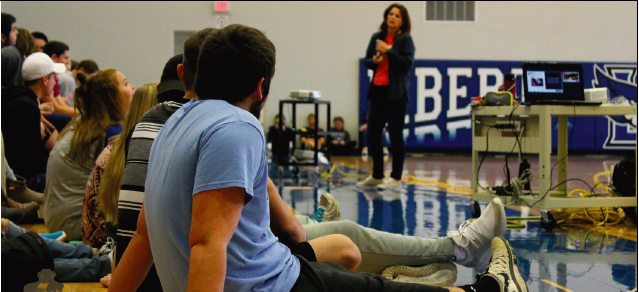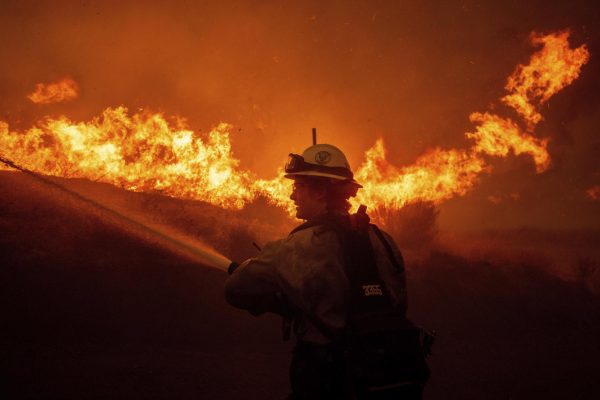#ICANHELP
The culture of bullying has gone from spit-balling and name-calling to shade-throwing and subtweeting faster than you can spell out your entire day using emojis. Bullying has cultivated over the past few decades to fit a new forum that can reach anyone and everyone: the internet. Recently, there has been an emergence of social media sites that feature the opportunity for anyone to connect. Unfortunately, social media also gives the opportunity for people to harass others behind the protection of a screen.
Deleting Negativity
Students filed into the new fieldhouse for the #ICANHELP assembly on November 8. They listened to the co-founder of the #ICanHelp project, Kim Karr, and gained knowledge to spread positivity online and maintain a forward-looking digital footprint.
“The thought process of #ICanHelp was definitely getting the education out to just as many students as you can,” Karr said. “So I was talking to students, asking, what are the needs, what are the problems. I was then trying to get the support from the snapchats and the twitters and the instagrams.”
The initial idea to have this non-profit organization come to LHS came last March when a handful of StuCo members at the StuCo state convention heard the speakers there and decided our school needed to hear this message.
“The high school tries to bring in a couple of speakers each year to talk about important subjects,” StuCo leader Erin Ramsey said. “So much of our lives are lived online anymore that I think it’s really important that we talk about how to behave in a positive way online.”
There’s more to just spreading positivity required to make that change online and that’s to delete the negativity. Just because a person doesn’t seek out mean posts doesn’t mean there aren’t hurtful things posted.
“It’s negativity that causes a lot of issues in society today, especially with everything that’s going on in our world,” senior Drew Higgins said. “I think we all just need to be positive and happy and love each other.”
A gift and a curse with the anonymity that social media encompasses is the power teenagers get to type things they wouldn’t normally have the courage to say aloud.
“It’s just one of those things that now you have a fear and now this generation has been called the generation of wimps because you have all these fears and it makes you not want to do things,” Karr said.
In times of crisis, the world needs a leader. The same can be said for online issues regarding cyber-bullying. Accounts with a large following have a responsibility to post positively and shut down haters and trolls.
“A digital leader is someone who doesn’t put anything bad on social media and doesn’t bully people,” Higgins said. “Someone that sticks out in my mind is always trying to uplift people instead of putting people down.”
When a person allows themselves to be happy online and spread good thoughts, then that will reflect back onto them. If that person is posting cynical comments, they may experience negativity.
Being a leader online extends farther than a circle of friends it starts affecting school life and the future.
“I think it’s really important for students to really be thinking about themselves and the brand that they put out there on social media for themselves because that’s how they’re going to be viewed by the outside world,” counselor Scott Gillespie said. “So I think it’s really important that we use these social media accounts as an opportunity to show who we truly are.”
A substantial issue with social media is the lasting effect it has. It doesn’t matter if a person only sends a photo on snapchat to one person for one second, it made an impression on that device and others’ devices and will stay forever.
“I think too it’s instantaneous whereas you can see automatically who’s responding, who’s viewing, liking, disliking, retweeting, not retweeting,” administrator Bridget Herrman said. “It’s instantaneous so the gratification is not delayed, it’s now. It’s imprinted online if you can screenshot it.”
A digital footprint is a legacy imprinted on the earth for everyone to see.
Online, it can be difficult to establish the tone of an Instagram comment or the context of a subtweet. Even a simple joke between two friends can have consequences if taken too far.
“All it takes is several of those people who see it and going ‘yeah I believe that’ and then they fire it off to their own following and suddenly that spreads like a wildfire and that can be dangerous and really scary,” Gillespie said. “I think that we’ve seen the consequences with that, with student mental health, with victims of bullying and harassment going as far as committing suicide.”
People who face the future with optimism are the ones who are met with positive results which spreads to everyone around them.
“I talk to students everyday who have goals for their future and what they’re wanting to do but we’re starting to hear more and more of students who are losing those opportunities because somebody found things on social media or found their digital footprint and didn’t like what they saw,” Gillespie said.
A Solution
Change starts with one person. A post or text supporting others and standing against negative posts can set a chain reaction of spreading positivity.
“I just want it to be like I can go onto social media and I don’t have to worry about a Twitter fight or someone bashing on someone on their private account,” sophomore Maliyah Baker said.
It’s an easy thing to disconnect oneself from real life when behind a screen. Technology can be a good outlet to sometimes get away from the stresses of life, but that feeling of separation can become dangerous.
“When young adults post pictures that they’ve taken of people that they think look a certain way or acting a certain way that maybe they want to poke fun at, sometimes they forget that those are real people,” Ramsey said. “Ultimately, I want all of us to think before we post and if we wouldn’t want it said about ourselves then we probably shouldn’t post it.”
To prevent negativeness there needs to be positive mindsets of digital leaders and more defenders than bystanders.
“You just have to be there for people not only online but in real life too,” Galetti said.
Social media sites have policies put in place to terminate bullying and the option to block accounts, but hate still finds loopholes and appears. It’s up to everyone to put a plug to negativity online.
An example of a positive environment is the new social media site called ZeeMee, which helps students create a platform for colleges to see their professional side.
A few options to cease cyberbullying is making their account private and defending victims.
“I think that there’s always people that you can go to if you’re dealing with frustrations,” Gillespie said. “If you’re dealing with just stress, anxiety, whatever the case may be there are definitely healthier ways to cope with those things. Get out, be active, talk about it, find those other outlets that are more productive and a lot healthier.”







